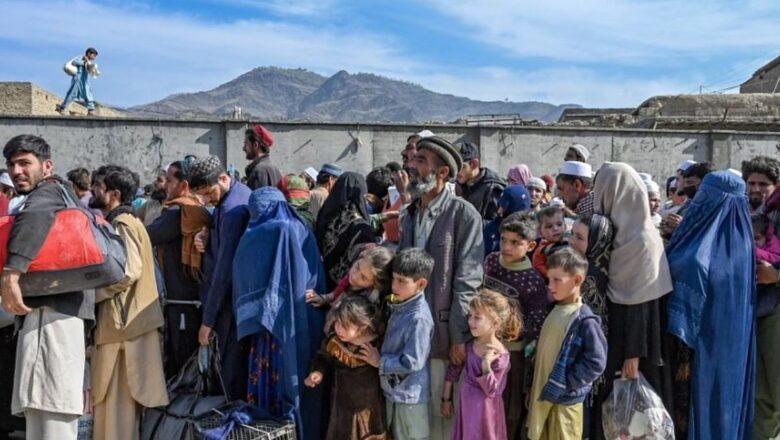
views
On October 3, Pakistan’s government announced that mass deportations of illegal Afghan immigrants would start on November 1. According to the Government of Pakistan, around 1.7 million Afghans were to be deported back to Afghanistan. So far, at least 600,000 Afghans have already been deported, and more than a million others face the same fate as the deportations continue. Pakistan’s decision to deport is centred around its rapidly disintegrating relationship with the Afghan Taliban which it has accused of supporting extremist groups like Tehreek-e-Taliban-Pakistan commonly known as TTP, for carrying out attacks on Pakistan’s establishment, a charge Taliban has vehemently denied.
Pakistan has been home to millions of Afghans for the last four decades. One of the most notable periods of migration began in 1979. After the Soviet invasion, many Afghan citizens began to flee the country. The ensuing decade of the Soviet-Afghan war saw the pouring over of thousands of Afghans into neighbouring Pakistan. In total, nearly three million Afghan refugees escaped to Pakistan throughout the decade, though some figures estimate that by 1990, nearly 4.5 million undocumented Afghan refugees resided throughout Pakistan. Around 2 million of them eventually got themselves registered as refugees with the Pakistani authorities.
Aided by the UNHCR, and primarily funded by the United States government, Pakistan continued to accept and support the inclusion of these Afghan refugees throughout the decade. In late 1988, roughly 3.3 million Afghan refugees were housed in 340 refugee camps along the Afghan-Pakistan border in the Khyber Pakhtunkhwa region along the Durand line. It was reported by The New York Times in November 1988 that about 100,000 refugees lived in the city of Peshawar and more than two million lived in a largely isolated region of Khyber Pakhtunkhwa of the then called North West Frontier Region. The region along the Afghan border still remains largely isolated from the rest of Pakistan with tribal rule of law governing the people.
With the Soviet invasion, Pakistan saw a perfect opportunity to use the tribal areas as a training base, for the refugee men they recruited from the same areas to fight the Soviets as Mujahideen. The tribal area subsequently became the defacto launch pad for launching the Mujaheddin into Afghanistan. Again in the 1990s, its isolation made it the perfect place, not only to host those engaged in the fight in Kashmir but also to train the Taliban before they moved to control most of Afghanistan.
In 2001, after the US invasion, the area once again became a natural refuge for the Taliban and for Al-Qaeda as well, as they again retreated largely into Waziristan and Quetta. This suited the Pakistani government. They could maintain the Taliban areas as a Talibanised belt between Afghanistan and Pakistan. As and when the government set up by the West in Afghanistan were to fall, this gave them the liberty to move back and to project their influence there.
However, by pursuing this policy, Pakistan created a monster which it thought it could control. For the Pakistani deep state, Afghan Taliban were fine for interfering in Afghanistan but the region became a breeding ground of religious fanaticism. It opposed the Pakistani government in equal terms as it was to the Afghan government as both were perceived as un-Islamic governments. After the Taliban returned to power in Afghanistan, these areas became their natural allies contrary to what the Pakistani planners had wished. Although they did fear the instability from Afghanistan spilling over the border into Pakistan, the strategic considerations were of far greater importance is what they thought then.
The tribal areas all along the Durand line are now largely out of Pakistan’s control, and the region is now turning out to be their worst nightmare as it has become the base for TTP and other extremist organisations attacking Pakistan. A region with rugged terrain and equally rugged men who, for years, have largely been governed traditionally as tribal people, and culturally as well as religiously, see themselves aligned towards the Afghan Taliban rather than the Pakistanis. With the Taliban in control of Afghanistan, it’s but natural that the people of this region are inclined loyally towards them.
For years the region around the Durand line became a safe haven for the Pakistani deep state which was led by its intelligence agency ISI, to carry out covert and subversive activities inside Afghanistan, against the US-led coalition forces. They used the region to their strategic advantage in the war against terror. They set up smuggling syndicates all along this region, smuggling narcotics and arms which largely funded its operations not only in Afghanistan but also in neighbouring Kashmir valley. The ISI operated with brazen contempt, by aiding and abetting the Taliban against its biggest ally the United States, with an objective of controlling Afghanistan after the latter withdraws. That objective has failed miserably as the current refugee crisis escalates and so does the attack carried out by TTP within Pakistan.
Though the Pakistani establishment blames the Taliban for all the ills within, in reality, the recent security crisis stems from Pakistan’s inability to reign in terror groups and leaders operating within Pakistan. These leaders have mastered the art of running with the hares and hunting with the hounds, wherein their intricate relationship with the Afghan Taliban on one end and with the Pakistani establishment on the other is just one of the examples of how complicated Pakistani national security issue is vis-a-vis to its homegrown terror organisations.
Terror organisations like Jaish-e-Mohammed, Lashkar-e-Toiba, Harkat-ul-Mujahideen and others have actively partnered with the Taliban during the American invasion. The close-knit religious and ideological binding between these organisations has made the situation far more complex for Pakistan than most would understand.
The interplay among these organisations would make it very difficult for Pakistan to get the better of its unseen enemy, the “Islamist terrorism”, which largely is a homegrown problem for Pakistan. The Taliban has been successful in putting its stamp on the regions of Khyber Pakhtunkhwa and adjoining FATA areas but the real challenge comes from other extremist organisations which operate in the urban heart of Pakistan and aspire to impose the Islamic Sharia law on their fellow citizens, similar to that imposed by the Taliban in Afghanistan.
The expulsion of the Afghan refugees further complicates the relationship between Pakistan and the Afghan Taliban which is already fraught with deep mistrust and holds diametrical opposite views on the nature of Durand line.
What truly hasn’t augured well for the Afghans is the humiliating treatment of the deported refugees at the hands of Pakistani security agencies. The refugees have been brazenly looted and robbed of their possessions before being deported across the border. They have been forced to part away with their earnings and possessions before being pushed back into Afghanistan.
Pakistan’s decision of deportation aimed at humiliating the Taliban and then using the humiliation as a bargaining chip to bring the Taliban into submission is fraught with serious miscalculations and repercussions. On the contrary, if history is to be taken as a testament, Afghans haven’t taken any form of humiliation head down and have paid back in somewhat equal terms or more than the actual bargain.
Pakistan, by playing hardball with the hope that it will deter the Afghan Taliban from covertly supporting the TTP and Baloch insurgents for the time being, has seriously miscalculated the aftermath of these events. It has inadvertently set its own foot on its own laid-out landmine, which will potentially blow the situation out of proportion. An imminent blowback from Afghanistan is around the corner.
This winter is going to be a hot one in Pakistan as far as the violence is concerned but it will be the coming spring that will spring up surprise which the Pakistani military in itself will find difficult to control. The hostility with the Afghan Taliban will turn Pakistan’s state policy of using terrorism as a tool to acquire strategic depth into a potential graveyard of its own death.
Raja Muneeb is an independent journalist and a columnist, a geo political and a Nat Sec analyst. Views expressed in the above piece are personal and solely that of the author. They do not necessarily reflect News18’s views.




















Comments
0 comment